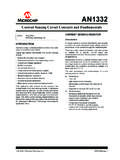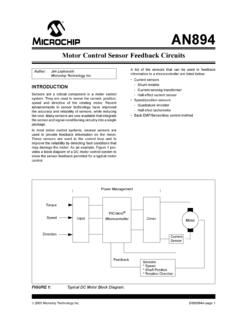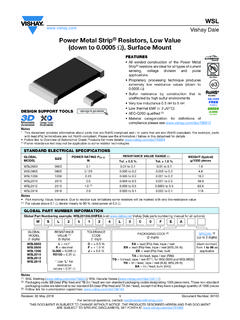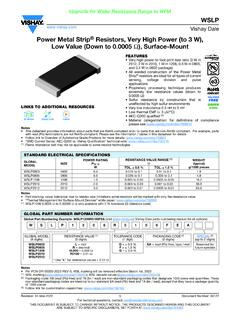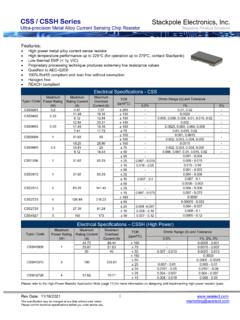Transcription of High-voltage resonant controller - STMicroelectronics
1 Not for new designThis is information on a product still in production but not recommended for new 2009 Rev 31/3636L6599 High-voltage resonant controllerFeatures 50 % duty cycle, variable frequency control of resonant half-bridge High-accuracy oscillator Up to 500 kHz operating frequency Two-level OCP: frequency-shift and latched shutdown Interface with PFC controller Latched disable input Burst-mode operation at light load Input for power-ON/OFF sequencing or brownout protection Non-linear soft-start for monotonic output voltage rise 600 V-rail compatible high-side gate driver with integrated bootstrap diode and high dV/dt immunity -300/800 mA high-side and low-side gate drivers with UVLO pull-down DIP-16, SO-16N packages Applications LCD and PDP TV Desktop PC, entry-level server Telecom SMPS AC-DC adapter.
2 Open frame SMPST able codeOrder codesPackagePackagingL6599 DSO-16 NTubeL6599 DTRSO-16 NTape and diagramSTANDBYDI SI SEN_DI SGNDI fmin LC LV GUV DETECTIONVs HVGSYNCHRONOUSBOOTSTRAP DIODEHVG DRIVER LVG D RIVERCssCFDISABLE +-DISLINEDEAD TIME +-+-LEVELSHIFTER12 87431 QRUVLOUVLOQ SRUVLOCONTROLLOGIC+-LI NE_O ADI SI O-+ ANDBY+-STBY5 DRIVING LOGIC 2V2 DELAYC ontentsL65992/36 Contents1 Device description .. 32 Pin settings .. 43 Typical system block diagram .. 64 Electrical data .. ratings .. data .. 75 Electrical characteristics .. 86 Typical electrical performance .. 117 Application information.
3 At no load or very light load .. sense, OCP and OLP .. shutdown .. sensing function .. section .. example .. 318 Package mechanical data .. 339 Revision history .. 35L6599 Device description 3/361 Device descriptionThe L6599 is a double-ended controller specific for the resonant half-bridge topology. It provides 50 % complementary duty cycle: the high-side switch and the low-side switch are driven ON\OFF 180 out-of-phase for exactly the same time. Output voltage regulation is obtained by modulating the operating frequency. A fixed dead-time inserted between the turn-OFF of one switch and the turn-ON of the other one guarantees soft-switching and enables high-frequency drive the high-side switch with the bootstrap approach, the IC incorporates a High-voltage floating structure able to withstand more than 600 V with a synchronous-driven High-voltage DMOS that replaces the external fast-recovery bootstrap diode.
4 The IC enables the designer to set the operating frequency range of the converter by means of an externally programmable start-up, to prevent uncontrolled inrush current, the switching frequency starts from a programmable maximum value and progressively decays until it reaches the steady-state value determined by the control loop. This frequency shift is non linear to minimize output voltage overshoots; its duration is programmable as IC can be forced to enter a controlled burst-mode operation at light load, so as to keep converter's input consumption to a minimum. IC's functions include a not-latched active-low disable input with current hysteresis useful for power sequencing or for brownout protection, a current sense input for OCP with frequency shift and delayed shutdown with automatic restart.
5 A higher level OCP latches off the IC if the first-level protection is not sufficient to control the primary current. Their combination offers complete protection against overload and short circuits. An additional latched disable input (DIS) allows easy implementation of OTP and/or OVP. An interface with the PFC controller is provided that enables to switch off the pre-regulator during fault conditions, such as OCP shutdown and DIS high, or during burst-mode settingsL65994/36 2 Pin ConnectionFigure connection (top view) functions start. This pin connects an external capacitor to GND and a resistor to RFmin (pin 4) that set both the maximum oscillator frequency and the time constant for the frequency shift that occurs as the chip starts up (soft-start).
6 An internal switch discharges this capacitor every time the chip turns OFF (VCC < UVLO, LINE < V or > 6 V, DIS > V, ISEN > V, DELAY > V) to make sure it will be soft-started next, and when the voltage on the current sense pin (ISEN) exceeds , as long as it stays above shutdown upon overcurrent. A capacitor and a resistor are connected from this pin to GND to set both the maximum duration of an overcurrent condition before the IC stops switching and the delay after which the IC restarts switching. Every time the voltage on the ISEN pin exceeds V the capacitor is charged by an internal 150 A current generator and is slowly discharged by the external resistor .
7 If the voltage on the pin reaches 2 V, the soft start capacitor is completely discharged so that the switching frequency is pushed to its maximum value and the 150 A is kept always on. As the voltage on the pin exceeds V the IC stops switching and the internal generator is turned OFF, so that the voltage on the pin will decay because of the external resistor . The IC will be soft-restarted as the voltage drops below In this way, under short circuit conditions, the converter will work intermittently with very low input average capacitor. A capacitor connected from this pin to GND is charged and discharged by internal current generators programmed by the external network connected to pin 4 (RFmin) and determines the switching frequency of the converter.
8 L6599 Pin settings 5 oscillator frequency setting. This pin provides a precise 2 V reference and a resistor connected from this pin to GND defines a current that is used to set the minimum oscillator frequency. To close the feedback loop that regulates the converter output voltage by modulating the oscillator frequency, the phototransistor of an optocoupler will be connected to this pin through a resistor . The value of this resistor will set the maximum operating frequency. An R-C series connected from this pin to GND sets frequency shift at start-up to prevent excessive energy inrush (soft-start).5 STBYB urst-mode operation threshold.
9 The pin senses some voltage related to the feedback control, which is compared to an internal reference ( V). If the voltage on the pin is lower than the reference, the IC enters an idle state and its quiescent current is reduced. The chip restarts switching as the voltage exceeds the reference by 50 mV. Soft-start is not invoked. This function realizes burst-mode operation when the load falls below a level that can be programmed by properly choosing the resistor connecting the optocoupler to pin RFmin (see block diagram). Tie the pin to RFmin if burst-mode is not sense input. The pin senses the primary current though a sense resistor or a capacitive divider for lossless sensing .
10 This input is not intended for a cycle-by-cycle control; hence the voltage signal must be filtered to get average current information. As the voltage exceeds a V threshold (with 50 mV hysteresis), the soft-start capacitor connected to pin 1 is internally discharged: the frequency increases hence limiting the power throughput. Under output short circuit, this normally results in a nearly constant peak primary current. This condition is allowed for a maximum time set at pin 2. If the current keeps on building up despite this frequency increase, a second comparator referenced at V latches the device off and brings its consumption almost to a before start-up level.











